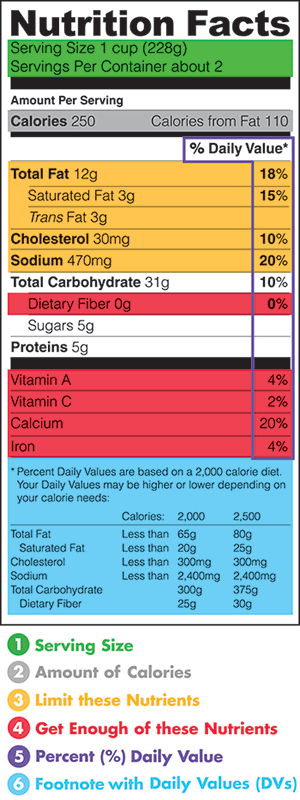For Consumers
Nutrition Facts Label: 20 and Evolving
 Get Consumer Updates by E-mail
Get Consumer Updates by E-mail
 Share this article (PDF 210 K)
Share this article (PDF 210 K)
On this page:
When you're walking down the aisles of a supermarket, it's not unusual to see fellow shoppers reading the information on the back of a food package, box or can. They might want to know how many calories are in the food, or they might be watching their sodium intake.
They could be trying to limit sugars and eat more dietary fiber. Or they could be parents trying to make the most nutritious choices for their children.
All this information is available thanks to an important addition to food packaging that was introduced to the American public 20 years ago: the Nutrition Facts label. This familiar rectangular box provides, in a standard format, important information about the nutritional content for most packaged foods, including breads, cereals, canned and frozen foods, snacks, desserts and drinks.
"It was revolutionary," says Jessica Leighton, Ph.D., senior nutrition science and policy advisor in FDA's Office of Foods and Veterinary Medicine. "For the first time, people had consistent information they need right at the point of purchase for the majority of packaged food products."
In the years since FDA issued the final rule for this labeling on Jan. 6, 1993, the Nutrition Facts label has influenced many companies to make their foods more healthful. Additionally, notes Claudine Kavanaugh, Ph.D.,M.P.H.,R.D., a scientist at the agency, "FDA was really a trailblazer in nutrition labeling. The Nutrition Facts label has been adapted by countries around the world that have chosen to mandate food labeling."
Label Use Increasing
The Nutrition Facts label was mandated after passage of the Nutrition Labeling and Education Act of 1990. Before it became standard practice, manufacturers provided nutritional information on a voluntary basis that wasn't consistent from product to product, explains Felicia Billingslea, M.S., director of FDA's food labeling and standards staff.
"The label is all about the attributes of the food," says Billingslea. "It's not to say that this is a good food or a bad food. It provides information that consumers can use and rely upon in developing healthful diets for themselves."
FDA survey data shows that use of the Nutrition Facts label has been increasing. In comparing the Health and Diet Survey conducted in 2002 with the most recent one conducted in 2008, the percentage of consumers reporting that they often use the label rose from 44 to 54 percent.
This usage has influenced many companies to change their ingredients to make the foods more healthful and thus more appealing to many consumers.
FDA cites as an example the decrease in consumption of trans fat, which has been linked to heart disease, primarily because of a decrease in manufacturers' use of partially hydrogenated oils. From the late 1990s to 2010, trans fat intake in adults decreased from 4.6 grams to 1.3 grams per day, with most of the reduction occurring after trans fat was added to the food label in 2003.
Changes to be Proposed
The agency is planning to update the Nutrition Facts label based on the latest science-based nutrition recommendations.
Paula Trumbo, Ph.D., acting director of FDA's nutrition programs staff explains that updates are being assessed to address such factors as current nutrient recommendations, public health concerns based on recent data on food consumption, and the agency's desire to make this information as clear and useful as possible.
The updates are still being formulated. Public input will be sought when they are proposed.
Online Resources Available
FDA public health educator Lisa Lubin, M.S., R.D., notes that the agency has extensive online resources to assist consumers in using the label at www.fda.gov/nutritioneducation, including:
- An explanation of the meaning and use of each line of the Nutrition Facts label
- A guide to using the label to choose healthful foods
- Practical tips for using the label to reduce sodium in your diet
- The Spot the Block campaign that challenges kids from 9 to 13 to use the label
- A how-to guide for older adults
Lubin says the label is important for both young and old. "Use of the label in childhood can be the foundation for a lifetime of healthful eating habits," she says, "It can also help reduce the risk of diseases that are common among older adults."
This article appears on FDA's Consumer Updates page, which features the latest on all FDA-regulated products.
January 9, 2013









